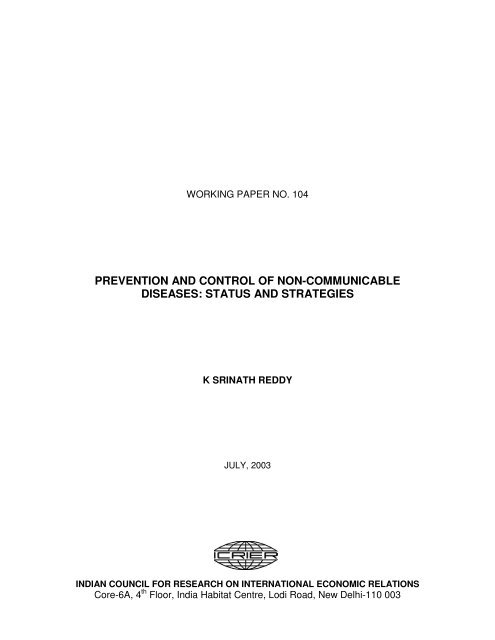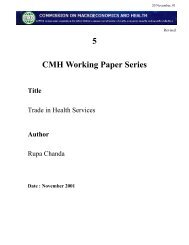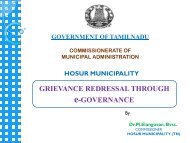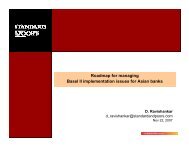prevention and control of non-communicable diseases - icrier
prevention and control of non-communicable diseases - icrier
prevention and control of non-communicable diseases - icrier
Create successful ePaper yourself
Turn your PDF publications into a flip-book with our unique Google optimized e-Paper software.
WORKING PAPER NO. 104<br />
PREVENTION AND CONTROL OF NON-COMMUNICABLE<br />
DISEASES: STATUS AND STRATEGIES<br />
K SRINATH REDDY<br />
JULY, 2003<br />
INDIAN COUNCIL FOR RESEARCH ON INTERNATIONAL ECONOMIC RELATIONS<br />
Core-6A, 4 th Floor, India Habitat Centre, Lodi Road, New Delhi-110 003
Contents<br />
Foreword.............................................................................................................................i<br />
Introduction ....................................................................................................................... 1<br />
Determinants <strong>of</strong> Health Transition.................................................................................. 2<br />
Socio-economic Impact <strong>of</strong> NCDs <strong>and</strong> Equity Issues ...................................................... 3<br />
Burden <strong>of</strong> NCDs (Present <strong>and</strong> Projected)....................................................................... 4<br />
Strategies............................................................................................................................ 9<br />
Implementation................................................................................................................ 11<br />
Issues in the Delivery <strong>of</strong> Chronic Care.......................................................................... 15<br />
Chronic Care <strong>and</strong> Optimisation <strong>of</strong> Available Resources .................................................. 15<br />
Overcoming the Barriers................................................................................................... 22<br />
Prioritisation <strong>of</strong> Interventions........................................................................................... 27<br />
References ........................................................................................................................ 29
Foreword<br />
This paper formed part <strong>of</strong> a series <strong>of</strong> background papers prepared for the ICRIER<br />
India Health Study, “Changing the Indian Health System: Current Issues, Future<br />
Directions” by Rajiv L. Misra, Rachel Chatterjee, <strong>and</strong> Sujatha Rao. The India Health<br />
Study, prepared under the team leadership <strong>of</strong> Rajiv Misra, former Health Secretary,<br />
Government <strong>of</strong> India, was funded by the Bill <strong>and</strong> Melinda Gates Foundation.<br />
Among the major health transitions witnessed in the second half <strong>of</strong> the twentieth<br />
century, the most globally pervasive change has been the rising burden <strong>of</strong> <strong>non</strong><strong>communicable</strong><br />
<strong>diseases</strong> (NCDs). This has given rise to new challenges <strong>of</strong> providing acute<br />
<strong>and</strong> chronic care for NCDs, especially in poor countries such as India with an already<br />
existing mismatch between health care needs <strong>and</strong> resources. This paper examines the<br />
socio-economic impact <strong>and</strong> burden <strong>of</strong> NCDs <strong>and</strong> discusses various strategies for the<br />
<strong>prevention</strong> <strong>and</strong> <strong>control</strong> <strong>of</strong> such <strong>diseases</strong> in India. It recommends that existing health<br />
systems will need to be reorganized <strong>and</strong> reoriented to include the <strong>prevention</strong>,<br />
surveillance, <strong>and</strong> management <strong>of</strong> NCDs. The paper also recommends that evidence based<br />
clinical practice <strong>and</strong> appropriate use <strong>of</strong> technologies should be promoted at all levels <strong>of</strong><br />
health care, including tertiary services.<br />
The <strong>prevention</strong> <strong>and</strong> <strong>control</strong> <strong>of</strong> NCDs poses a major public health challenge for the<br />
country in the twenty-first century. I am very pleased that ICRIER has had the<br />
opportunity to participate in the debate in this area. This contribution by K. Srinath<br />
Reddy will help significantly in providing a better focus to the problems <strong>and</strong> solutions at<br />
h<strong>and</strong>.<br />
July 2003<br />
Arvind Virmani<br />
Director & Chief Executive<br />
ICRIER<br />
i
Introduction<br />
The second half <strong>of</strong> the twentieth century witnessed major health transitions in the<br />
world, propelled by socio-economic <strong>and</strong> technological changes which pr<strong>of</strong>oundly altered<br />
life expectancy <strong>and</strong> ways <strong>of</strong> living while creating an unprecedented human capacity to<br />
use science to both prolong <strong>and</strong> enhance life. Among these health transitions, the most<br />
globally pervasive change has been the rising burden <strong>of</strong> <strong>non</strong>-<strong>communicable</strong> <strong>diseases</strong><br />
(NCDs). Epidemics <strong>of</strong> <strong>non</strong>-<strong>communicable</strong> <strong>diseases</strong> (NCD) are presently emerging or<br />
accelerating in most developing countries (Murray <strong>and</strong> Lopez 1996). Even as infections<br />
<strong>and</strong> nutritional deficiencies are receding as leading contributors to death <strong>and</strong> disability,<br />
cardiovascular <strong>diseases</strong> (CVDs), cancers, diabetes, neuropsychiatric ailments, <strong>and</strong> other<br />
chronic <strong>diseases</strong> are becoming major contributors to the burden <strong>of</strong> disease. India too<br />
illustrates this health transition, which positions NCDs as a major public health challenge<br />
<strong>of</strong> growing magnitude in the twenty-first century.<br />
As India experiences a rapid health transition, the mismatch between health care<br />
needs <strong>and</strong> resources is widened by an exp<strong>and</strong>ed list <strong>of</strong> health conditions that vie for<br />
attention from policy-makers <strong>and</strong> public health action while posting competing claims for<br />
clinical care. The complexities are compounded when policy has to prioritise on the<br />
basis <strong>of</strong> disease burdens, cost-effectiveness, <strong>and</strong> equity while the delivery systems have<br />
to simultaneously cope with the transformative pressures <strong>of</strong> economic restructuring <strong>and</strong><br />
health care reforms. The challenges <strong>of</strong> providing acute <strong>and</strong> chronic care for NCDs in such<br />
settings are immense, yet the imperatives <strong>of</strong> proper planning <strong>and</strong> performance for<br />
delivering such care become increasingly urgent as health transition rapidly rewrites a<br />
new agenda for health care in the India.<br />
Existing health systems need to be reorganised, reoriented, <strong>and</strong> recruited to<br />
deliver the exp<strong>and</strong>ed m<strong>and</strong>ate <strong>of</strong> health care involving the <strong>prevention</strong>, surveillance <strong>and</strong><br />
management <strong>of</strong> chronic <strong>diseases</strong>. The sustained nature <strong>of</strong> preventive interventions,<br />
required over many years, as well as the growing dem<strong>and</strong> for acute <strong>and</strong> chronic care <strong>of</strong><br />
NCDs will need to be accommodated into the agenda <strong>of</strong> primary <strong>and</strong> secondary health<br />
1
care. Surveillance <strong>of</strong> NCDs <strong>and</strong> their risk factors should also become an integral function<br />
<strong>of</strong> health systems, complementary to the other surveillance functions they are currently<br />
performing. Evidence based clinical practice <strong>and</strong> appropriate use <strong>of</strong> technologies should<br />
be promoted at all levels <strong>of</strong> health care, including tertiary services.<br />
Determinants <strong>of</strong> Health Transition<br />
Health transition, whereby NCDs become the dominant contributor to the burden<br />
<strong>of</strong> disease, is principally due to a combination <strong>of</strong> demographic <strong>and</strong> lifestyle changes that<br />
result from socio-economic development. Demographic transition is characterised by a<br />
decline in mortality, followed by a drop in fertility. During this transition, the age<br />
structure <strong>of</strong> the population changes from a pyramidical shape to a more columnar shape,<br />
as fertility declines <strong>and</strong> the population ages. This is then reflected in the pr<strong>of</strong>ile <strong>of</strong> the<br />
causes <strong>of</strong> death. As industrialisation <strong>and</strong> urbanisation occur, there is a decline in the<br />
mortality attributable to infectious <strong>diseases</strong> <strong>and</strong> nutritional disorders. As more<br />
individuals survive to enter the middle ages, the years <strong>of</strong> exposure to the risk factors <strong>of</strong><br />
chronic disease increase. Simultaneously, urbanisation, industrialisation, <strong>and</strong><br />
globalisation are <strong>of</strong>ten accompanied by several undesirable lifestyle alterations in the<br />
form <strong>of</strong> a diet rich in saturated fat, salt, <strong>and</strong> excess calories, decreased physical activity,<br />
addictions like tobacco <strong>and</strong> alcohol, <strong>and</strong> augmentation <strong>of</strong> psychosocial stress. Thus the<br />
dose <strong>and</strong> duration <strong>of</strong> risk factor exposure both increase, resulting in large numbers<br />
manifesting lifestyle related <strong>diseases</strong> <strong>and</strong> their consequences. Health transition is<br />
characterised by a demographic transition in the age pr<strong>of</strong>ile <strong>and</strong> an epidemiologic<br />
transition marked by the shift in the cause <strong>of</strong> death pr<strong>of</strong>ile with the increasing dominance<br />
<strong>of</strong> NCDs (Omran 1971; Olshansky <strong>and</strong> Ault 1986).<br />
In addition, recent evidence suggests that impaired foetal nutrition, reflected in<br />
small birth size, results in programmed susceptibility adult cardiovascular disease,<br />
diabetes, <strong>and</strong> some cancers. Migrant Indians have also been shown to have excess rates <strong>of</strong><br />
coronary heart disease (CHD) <strong>and</strong> diabetes in comparison to other ethnic groups,<br />
indicating a magnified response to environmental change. These factors will adversely<br />
2
impact on the future burden <strong>of</strong> NCDs, as India experiences health transition (Reddy <strong>and</strong><br />
Yusuf 1998; Reddy 1999).<br />
Socio-economic Impact <strong>of</strong> NCDs <strong>and</strong> Equity Issues<br />
Death or disability from NCDs in the productive middle ages results in major<br />
economic burdens on the affected individuals, their families, <strong>and</strong> society as a whole. The<br />
management <strong>of</strong> established NCDs (diagnosis <strong>and</strong> therapy) is <strong>of</strong>ten technology-intensive<br />
<strong>and</strong> expensive. Individual as well as societal resources are already being drained, at a<br />
disproportionately high level, by the tertiary care management <strong>of</strong> NCDs, <strong>of</strong>ten drawing<br />
scarce resources away from the unfinished agenda <strong>of</strong> infectious disease <strong>and</strong> nutritional<br />
disorder <strong>control</strong>.<br />
Though NCD epidemics usually originate in the upper socio-economic strata, they<br />
diffuse across the social spectrum, with the social gradient ultimately reversing <strong>and</strong> the<br />
poor becoming predominantly afflicted. Indeed, in the more mature stages <strong>of</strong> these<br />
epidemics, the poor are the <strong>of</strong>ten worst afflicted in terms <strong>of</strong> disease <strong>and</strong> usually the most<br />
marginalised in terms <strong>of</strong> care. This historical experience <strong>of</strong> the developed countries,<br />
where the NCD epidemics matured over the past half-century, is likely to be replicated in<br />
the developing countries in the coming half-century. There is recent evidence from some<br />
Indian studies that the social gradient for CVDs has already begun to reverse in some<br />
population groups in India, especially in 1arge urban settings (World Bank 1999).<br />
Tobacco consumption is also higher in rural as compared to urban populations <strong>and</strong> in the<br />
poor as compared to the rich population groups. The future risk <strong>of</strong> tobacco-related NCDs<br />
is, therefore, likely to be higher in these groups (Chadha et al. 1997; Reddy 1993). A<br />
comparison <strong>of</strong> per capita income pr<strong>of</strong>ile <strong>and</strong> death rates in Punjab, Maharashtra, Andhra<br />
Pradesh, <strong>and</strong> Orissa in 1988 reveals that as per capita income pr<strong>of</strong>ile progressively<br />
declines from Punjab to Orissa, the probability <strong>of</strong> death between the ages <strong>of</strong> 15 <strong>and</strong> 60<br />
years progressively rises (19 per cent, 27 per cent, 34 per cent, <strong>and</strong> 38 per cent<br />
respectively). NCDs are a major contributor to deaths in this age group.<br />
3
These post-transitional <strong>diseases</strong> also have macro <strong>and</strong> micro economic impacts<br />
which may prolong the high burden <strong>of</strong> pre-transitional <strong>diseases</strong> in developing country<br />
settings. The loss, due to death <strong>and</strong> disability, <strong>of</strong> productive persons in mid-life, cripples<br />
development <strong>and</strong> perpetuates social conditions which foster <strong>communicable</strong> <strong>and</strong><br />
nutritional disorders. The loss <strong>of</strong> a wage earner in the family has devastating effects on<br />
the nutrition, education, <strong>and</strong> health care access <strong>of</strong> other family members, especially<br />
young dependents. The twin agendas <strong>of</strong> health care, m<strong>and</strong>ated by pre-<strong>and</strong> posttransitional<br />
<strong>diseases</strong>, are not competitively exclusive but are synergistically<br />
complementary. The goal <strong>of</strong> extending health care benefits across an exp<strong>and</strong>ing lifespan<br />
requires that these two agendas be harmonised in India, as we brace up to meet the<br />
challenges <strong>of</strong> health transition.<br />
Much <strong>of</strong> these economic <strong>and</strong> health burdens could be obviated<br />
(a)<br />
(b)<br />
in the short term by strategies which involve low-cost screening for early<br />
detection <strong>of</strong> NCDs in whom early interventions effectively alter the natural<br />
history <strong>of</strong> disease <strong>and</strong> the use <strong>of</strong> the several low cost, high impact<br />
interventions for secondary <strong>prevention</strong> <strong>and</strong> clinical care which are now readily<br />
available <strong>and</strong><br />
in the long term by investment in population based <strong>prevention</strong> strategies for<br />
preventing the acquisition or augmentation <strong>of</strong> risk in hitherto low-risk<br />
populations <strong>and</strong> reduction <strong>of</strong> risk in populations already affected by health<br />
transition.<br />
Burden <strong>of</strong> NCDs (Present <strong>and</strong> Projected)<br />
Even at the present stage <strong>of</strong> health transition, India contributes substantially to the<br />
global burden <strong>of</strong> NCDs. In 1990, India accounted for 19 per cent <strong>of</strong> all deaths, 16 per cent<br />
<strong>of</strong> all NCD deaths, <strong>and</strong> 17 per cent <strong>of</strong> all CVD deaths in the world. CVDs in India alone<br />
accounted for around 2.4 million deaths, in contrast to nearly 3.2 million deaths due to<br />
that cause in all the industrialised countries together (Murray <strong>and</strong> Lopez 1996).<br />
4
While the present high burden <strong>of</strong> NCD deaths is itself an adequate reason for<br />
public health attention, a greater cause for concern is the early age <strong>of</strong> these deaths in<br />
India compared to the developed countries. More NCD deaths in India occur in middleage<br />
(35–69 years) than in industrialised countries, where they occur largely in old age<br />
(>70 years). Even as the overall NCD burdens will rise sharply by 2020 (Tables I <strong>and</strong> II),<br />
disproportionate loss <strong>of</strong> lives in mid-life will continue to constitute a major burden (Table<br />
III). Table IV provides a comparison between India <strong>and</strong> established market economies<br />
(EME). In India, 52.2 per cent <strong>of</strong> all CVD deaths in 1990 occurred before the age <strong>of</strong> 70<br />
years, in contrast to 22.8 per cent in the EME countries (Murray <strong>and</strong> Lopez 1996; Reddy<br />
<strong>and</strong> Yusuf 1998).<br />
Deaths 1990<br />
(thous<strong>and</strong>s)<br />
Deaths 2020<br />
(thous<strong>and</strong>s)<br />
DALYs 1990<br />
(thous<strong>and</strong>s)<br />
DALYs 2020<br />
(thous<strong>and</strong>s)<br />
Table I<br />
GBOD Estimates for India (1990, 2020)<br />
India (1990)<br />
Population = 850 million<br />
India (2020)<br />
Population = 1267 million<br />
Group I Group II Group III Total<br />
4775<br />
(51.0%)<br />
2461<br />
(21.6%)<br />
162,354<br />
(56.4%)<br />
57,756<br />
(24.4%)<br />
3788<br />
(40.4%)<br />
7627<br />
(66.7%)<br />
83,437<br />
(29.0%)<br />
133,770<br />
(56.5%)<br />
808<br />
(8.6%)<br />
1342<br />
(11.7%)<br />
41,947<br />
(14.6%)<br />
45,285<br />
(19.1%)<br />
Group I = Communicable, maternal, perinatal, <strong>and</strong> nutritional conditions<br />
Group II = Non-<strong>communicable</strong> Disease<br />
Group III = Injuries<br />
DALY = Disability Adjusted Life Year<br />
GBOD = Global Burden <strong>of</strong> Disease<br />
Source: Murray <strong>and</strong> Lopez (1996).<br />
9371<br />
11,430<br />
287,739<br />
236,741<br />
5
Table II<br />
Contribution <strong>of</strong> NCDs <strong>and</strong> Injuries to Mortality in India (1990, 2020)<br />
Cause <strong>of</strong> Death<br />
Cause-specific<br />
Proportionate Mortality<br />
(as % <strong>of</strong> total mortality)<br />
1990 2020<br />
Total NCD 40.4 66.7<br />
Cardiovascular 24.2 41.8<br />
Malignant neoplasm 5.4 11.4<br />
Neuropsychiatric 1.1 0.9<br />
Total Injuries 8.6 11.7<br />
Unintentional 6.9 9.5<br />
Intentional 1.6 2.2<br />
Source: Murray <strong>and</strong> Lopez (1996).<br />
Table III<br />
Mid-life Mortality due to NCDs in India (1990, 2020)<br />
Cause <strong>of</strong> Death<br />
Percentage <strong>of</strong> cause-specific mortality occurring in the<br />
age group <strong>of</strong> 30–69 yrs<br />
1990 2020<br />
Total NCD 48.9 51.3<br />
Cardiovascular 48.2 47.7<br />
Malignant neoplasm 64.6 69.2<br />
Neuropsychiatric 40.6 39.6<br />
Total Injuries 36.3 52.8<br />
Unintentional 34 52<br />
Intentional 45 56.4<br />
Source: Murray <strong>and</strong> Lopez (1996).<br />
Table IV<br />
Early Mortality due to NCDs in India (1990, 2020)<br />
Age pr<strong>of</strong>ile <strong>of</strong> NCD deaths<br />
(% <strong>of</strong> NCD deaths in each range)<br />
Age at Death India<br />
1990<br />
EME<br />
1999<br />
India<br />
2020<br />
EME<br />
2020<br />
70 yrs 38.9 74 44.6 74.5<br />
Source: Murray <strong>and</strong> Lopez (1996).<br />
6
The high prevalence <strong>of</strong> diabetes in urban <strong>and</strong> migrant Indians is also a cause for<br />
concern. Urban estimates <strong>of</strong> diabetes in adults aged over 35 years are in the range <strong>of</strong> 16–<br />
20 per cent, while the corresponding rural estimates are around 4 per cent. With such<br />
rates, it has been estimated that India has the largest number <strong>of</strong> diabetics in the world. As<br />
dietary habits worsen <strong>and</strong> physical activity decreases with resultant obesity, diabetes will<br />
become an increasingly frequent contributor to NCD. It has been estimated that the<br />
number <strong>of</strong> persons with diabetes will rise from 19.4 million in 1995 to 57.2 million in the<br />
world, even as India leads the global table for the number <strong>of</strong> diabetes (King et al. 1998).<br />
Since these estimates are based on older <strong>and</strong> higher cut-<strong>of</strong>f values for the diagnosis <strong>of</strong><br />
diabetes <strong>and</strong> also do not take into account the category <strong>of</strong> impaired glucose tolerance, the<br />
overall burdens <strong>of</strong> disease attributable to diabetic <strong>and</strong> pre-diabetics may be even higher<br />
than those projected.<br />
There will also be a sharp rise in disability adjusted life years (DALYs) lost due<br />
to NCDs between 1990 <strong>and</strong> 2020. This is illustrated by the rise in the DALY loss<br />
attributable to CVDs where India will be the global leader (Fig. 1).<br />
Figure 1<br />
Burden <strong>of</strong> CVDS, 1990–2020<br />
IND=India; CHI=China; SSA=Sub Saharan Africa; MEC=Middle Eastern Cresent;<br />
LAC=Latin American Countries; EME=Established Market Economies; FSE=Former<br />
Socialist Economies; OAI=Other Asia <strong>and</strong> Isl<strong>and</strong>s.<br />
Source: Murray <strong>and</strong> Lopez (1996).<br />
7
While these estimates (present <strong>and</strong> projected) are based on a variety <strong>of</strong> data<br />
sources <strong>of</strong> limited coverage <strong>and</strong> uncertain validity, they are the best available estimates<br />
from a globally acknowledged data source [the Global Burden <strong>of</strong> Disease (GBOD) study<br />
by Murray <strong>and</strong> Lopez in 1996]. Some Indian investigators have questioned the estimates<br />
for 1990, based on independent secondary analysis <strong>and</strong> modelling (An<strong>and</strong> 2000). The<br />
differences are not substantially large. While the precise dimensions <strong>of</strong> the epidemic may<br />
be difficult to gauge at present, the directions <strong>of</strong> its growth are indisputable.<br />
The prevalence/incidence <strong>of</strong> various NCDs for 1998 has also been estimated, for<br />
India, based on various published studies from different regions (An<strong>and</strong> 2000). These are<br />
pr<strong>of</strong>iled in Table V. These estimates may be relatively conservative, as suggested by the<br />
comparison with the diabetes prevalence estimates <strong>of</strong> the World Health Organization.<br />
Even then, it is estimated that about one-fifth <strong>of</strong> the population would have at least one <strong>of</strong><br />
these selected NCDs.<br />
Table V<br />
Estimated Number <strong>of</strong> Cases <strong>of</strong> Selected NCDs in India, 1998<br />
Disease Prevalence /<br />
incidence<br />
Number <strong>of</strong> cases % <strong>of</strong> total<br />
population<br />
All Cancers Prevalence 2 million 0.2<br />
Heart <strong>diseases</strong> (IHD, Prevalence 65 million 6.6<br />
HT, Stroke, RHD)<br />
Respiratory <strong>diseases</strong> Prevalence 65 million 6.6<br />
Diabetes mellitus Prevalence 13 million 1.3<br />
Injuries Incidence 7 million 0.70<br />
Source: An<strong>and</strong> (2000).<br />
The lag period between exposure to risk factors <strong>of</strong> NCDs <strong>and</strong> their clinical<br />
manifestations make current mortality rates unsuitable for prospective public health<br />
planning, since they only represent past exposures over some decades. The present levels<br />
<strong>of</strong> risk factor exposure would be more meaningful in predicting future risk <strong>and</strong> driving<br />
public health policy. The rising levels <strong>of</strong> hypertension, diabetes, obesity, tobacco<br />
consumption, <strong>and</strong> blood lipids in Indian population groups have been well documented in<br />
8
ecent years (Chadha et al. 1997; Reddy 1993; King et al. 1998; An<strong>and</strong> 2000; Gupta et al.<br />
1996). These too portend a major rise in future NCD burdens in India.<br />
Strategies<br />
follows.<br />
Principle 1:<br />
The principles <strong>of</strong> <strong>prevention</strong> which underline the strategies for NCD <strong>control</strong> are as<br />
Risk operates in a continuum—not across arbitrary thresholds; Risk<br />
reduction benefits across the range.<br />
Principle 2:<br />
Principle 3:<br />
Principle 4:<br />
Majority <strong>of</strong> NCD events arise in a population from the middle <strong>of</strong> the<br />
distribution (<strong>of</strong> a risk factor) than from its high end.<br />
Co-existence <strong>of</strong> risk factors leads to interactive risk which is<br />
multiplicative.<br />
The absolute risk <strong>of</strong> a major NCD event (e.g. CHD/stroke) is<br />
dependent on the overall risk pr<strong>of</strong>ile contributed by co-existent risk<br />
factors operating in a continuum.<br />
Traditionally, public health approaches to NCD <strong>control</strong> have been (a) a high risk<br />
strategy, targeting persons with high levels <strong>of</strong> risk factors <strong>and</strong> employing interventions to<br />
reduce them, usually with drugs <strong>and</strong> (b) a population strategy which attempts to reduce<br />
risk factor levels in the whole community, usually through lifestyle related measures<br />
(Rose 1985; Rose <strong>and</strong> Day 1990). The former provides higher benefits to individuals at<br />
maximum risk. However, since such individuals are a small segment <strong>of</strong> the society, there<br />
is no major impact on national morbidity or mortality on the country. The population<br />
approach aims at relatively modest reductions in the risk for each individual, but the<br />
cumulative benefits to the community are large since there are many more persons in the<br />
mild or moderate range <strong>of</strong> risk factor elevation than there are in the highest range. The<br />
two strategies are not mutually exclusive but are synergistically complementary.<br />
However, population-based <strong>and</strong> lifestyle linked strategies are likely to prevent the<br />
acquisition or augmentation <strong>of</strong> NCD risk factors in transitional societies like India, while<br />
avoiding the economic <strong>and</strong> biological costs <strong>of</strong> pharmacological risk reduction strategies<br />
practised in the developed countries.<br />
9
Simultaneously effective low-cost case-management strategies are required for<br />
persons who manifest disease. Such technologies are available but await widespread<br />
dissemination <strong>and</strong> application. For example, oral aspirin administration in cases <strong>of</strong><br />
suspected heart attack saves as many lives as the intravenously administered clot<br />
dissolving drug streptokinase (Antiplatelet Trialists Collaboration 1994). The community<br />
needs to be empowered, through information, to avail <strong>of</strong> such technologies, which are<br />
both feasible for wide application <strong>and</strong> are cost-effective (Table VI).<br />
Table VI<br />
Effect <strong>of</strong> Treatment <strong>of</strong> 1000 Patients with AMI<br />
Premature deaths<br />
avoided<br />
Cerebral<br />
haemorrages<br />
caused<br />
Aspirin 23 0 Rs. 152<br />
Cost per life saved<br />
Streptokinase 25 2–3 Rs. 123,560<br />
Source: Murray <strong>and</strong> Lopez (1996).<br />
At the population level, programmes for promotion <strong>of</strong> (a) a health promoting diet<br />
(calories appropriate to the level <strong>of</strong> physical activity; moderation in the intake <strong>of</strong><br />
saturated fat, salt, <strong>and</strong> refined sugar; high intake <strong>of</strong> fresh fruit <strong>and</strong> vegetables; fish in<br />
preference to red meat in <strong>non</strong>-vegetarian diets) <strong>and</strong> (b) adequate physical activity <strong>and</strong><br />
regular exercise are required. These are likely to have benefits for a wide range <strong>of</strong> NCDs,<br />
especially CVD, diabetes, hypertension, <strong>and</strong> some cancers which are related to saturated<br />
fat intake.<br />
Tobacco <strong>control</strong> is a major public health imperative which will provide the largest<br />
benefit, for NCD <strong>prevention</strong>. Tobacco-related cancers, CVD, <strong>and</strong> chronic obstructive<br />
airway disease are amongst the <strong>diseases</strong> which can be effectively prevented if abstinence<br />
from tobacco <strong>and</strong> cessation <strong>of</strong> the tobacco habit are encouraged in the population. It has<br />
been estimated that <strong>of</strong> all the teenagers who are currently smoking, half will eventually<br />
die <strong>of</strong> tobacco related <strong>diseases</strong> (a quarter in the middle age <strong>and</strong> a quarter at an older age).<br />
10
For those who die <strong>of</strong> tobacco related illnesses in the middle age, the average loss <strong>of</strong> lifeexpectancy<br />
compared to <strong>non</strong>-smokers is 20–26 years. Tobacco <strong>and</strong> AIDS represent the<br />
most rapidly growing causes <strong>of</strong> death, the former being the foremost preventable cause <strong>of</strong><br />
death in the modern world (World Bank 1999). Population based <strong>control</strong> strategies are<br />
clearly a high priority.<br />
The success <strong>of</strong> population based interventions, addressing multiple risk factors<br />
common to most NCDs, through lifestyle linked community programmes has been<br />
demonstrated both in developed <strong>and</strong> developing countries (Puska et al. 1995; Dowsen et<br />
al. 1995). Such population strategies require both ‘bottom-up’ (community health<br />
education <strong>and</strong> empowerment) <strong>and</strong> ‘top-down’ (legislation <strong>and</strong> regulation) approaches.<br />
Whether it is food (production, pricing, labelling) or tobacco (production, sale,<br />
advertising) or physical activity (a conducive transport policy which favours urban cycle<br />
lanes <strong>and</strong> curbs vehicular transport as well as provides facilities for leisure time exercise<br />
in community playgrounds), active health policy measures are required alongside public<br />
health education. An enlightened policy <strong>and</strong> an empowered community can together stall<br />
the advance <strong>of</strong> the emerging epidemics <strong>of</strong> NCDs in India.<br />
Presently, programmes for NCD <strong>control</strong> are <strong>non</strong>-existent or functioning at a low<br />
level in India. The National Cancer Control Programme involves cancer registries at<br />
selected sites <strong>and</strong> strengthening <strong>of</strong> facilities for clinical care (e.g. radiotherapy). Pilot<br />
studies for <strong>control</strong> <strong>of</strong> CVD <strong>and</strong> diabetes have been initiated but have not impacted on<br />
policy <strong>and</strong> programme development. Tobacco <strong>control</strong> is being accorded greater<br />
importance but awaits early passage <strong>of</strong> proposed legislation <strong>and</strong> a vigorous public<br />
education campaign.<br />
Implementation<br />
Programmes for the <strong>prevention</strong> <strong>and</strong> <strong>control</strong> <strong>of</strong> NCDs need to adopt a ‘life span’<br />
approach, attempt to reduce risk at stage <strong>of</strong> life through appropriate public health<br />
interventions. They also need to be variably integrated into different levels <strong>of</strong> health care<br />
11
(primary, secondary, <strong>and</strong> tertiary). The principal functions <strong>of</strong> such a programme would<br />
be: (a) to provide information <strong>and</strong> an enabling environment for increasing awareness <strong>and</strong><br />
adoption <strong>of</strong> health living habits by the community; (b) early detection <strong>of</strong> persons with<br />
risk factors <strong>and</strong> cost-effective interventions for reducing risk; (c) early detection <strong>of</strong><br />
persons with clinical disease <strong>and</strong> cost-effective care to prevent complications; (d) acute<br />
care, utilising low cost, high yield technologies; (e) secondary <strong>prevention</strong> to reduce, risk<br />
<strong>of</strong> the recurrent events; <strong>and</strong> (f) rehabilitation <strong>and</strong> palliative care, in cases where disease<br />
has resulted in complications or is incurable.<br />
Many <strong>of</strong> these activities can be performed in primary care settings (e.g. health<br />
education, blood pressure checks, tobacco cessation, chest pain algorithms, oral cancer<br />
screening). Some would need to be strengthened in secondary care (e.g. management <strong>of</strong><br />
some cancers, treatment <strong>of</strong> left ventricular dysfunction). In settings <strong>of</strong> tertiary care,<br />
technology needs to be utilised cost-effectively to provide advanced care as per clearly<br />
defined guidelines.<br />
The operational components are listed in Table VII.<br />
12
Area<br />
Prevention<br />
Table VII<br />
Implementation: Operational Components<br />
Essential package<br />
(core components)<br />
Tobacco <strong>control</strong><br />
(Taxation, Regulation, Education)<br />
Promotion <strong>of</strong> healthy diets<br />
(production, pricing, consumer<br />
empowerment) including the<br />
preparation <strong>and</strong> dissemination <strong>of</strong><br />
national food based dietary<br />
guidelines<br />
Promotion <strong>of</strong> physical activity<br />
(planning <strong>of</strong> cities <strong>and</strong> work-sites,<br />
community education)<br />
Optimal package<br />
(other components)<br />
Phasing out tobacco agriculture<br />
<strong>and</strong> industry (alternate crops <strong>and</strong><br />
occupations)<br />
National Nutrition Policy<br />
(involving agriculture <strong>and</strong><br />
industry)<br />
National Transport Policy<br />
(pollution <strong>control</strong> <strong>and</strong> promotion <strong>of</strong><br />
physical activity)<br />
Surveillance<br />
Screening<br />
Mass media campaigns – targeted<br />
special group programmes for<br />
community health educaiton<br />
School based programmes for<br />
‘Learning to Live Healthy’<br />
Tobacco consumption habits<br />
H/o Diabetes, Hypertension<br />
Blood Pressure<br />
Body Mass Index<br />
Waist circumference<br />
NCD mortality (by cause, age <strong>and</strong><br />
sex)<br />
National aggregate indicators<br />
(e.g., production <strong>and</strong> consumption<br />
<strong>of</strong> tobacco, fruit <strong>and</strong> vegetables)<br />
‘Opportunistic’ screening for:<br />
Tobacco consumption<br />
High Blood Pressure<br />
Overweight<br />
Central obesity<br />
COPD<br />
Cervical cancer<br />
Oral cancer<br />
13<br />
Blood lipids (total cholesterol,<br />
HDL cholesterol)<br />
Diabetes (by blood chemistry)<br />
Health beliefs<br />
Dietary consumption patterns<br />
Physical activity patterns<br />
NCD morbidity (disability)<br />
‘Targeted’ screening for:<br />
Diabetes<br />
Dyslipidemia<br />
Other cancers<br />
Transient ischaemic attacks<br />
(Contd.…)
(Table VII Contd.)<br />
Management<br />
Health Systems<br />
Research<br />
Clinical algorithms for:<br />
Acute myocardial infarction<br />
High blood pressure<br />
Congestive heat failure<br />
Diabetes<br />
Transient ischaemic attacks<br />
Childhood leukaemias<br />
Other cancers (e.g., oral, breast,<br />
cervical)<br />
COPD<br />
Integrate core components <strong>of</strong><br />
<strong>prevention</strong>, surveillance, screening,<br />
<strong>and</strong> management into primary <strong>and</strong><br />
secondary health care<br />
Strengthen health provider<br />
education (learning <strong>and</strong> skills<br />
relevant to NCD <strong>control</strong>)<br />
Enhance the knowledge <strong>and</strong><br />
decision making ability <strong>of</strong> health<br />
care managers in the elements <strong>of</strong><br />
NCD <strong>control</strong><br />
Implement essential drugs policy<br />
for provision <strong>of</strong> NCD related drugs<br />
Strengthen capacity for research<br />
relevant to NCD <strong>control</strong> through<br />
national <strong>and</strong> international<br />
partnerships (Implementation<br />
research, to effectively apply<br />
available knowledge)<br />
Clinical Algorithms for:<br />
Angina<br />
Dyslipidemia<br />
Stroke<br />
Other cancers<br />
Obesity<br />
Strengthen quality assurance in<br />
NCD related health care delivery<br />
Perform technology audits to<br />
identify <strong>and</strong> correct inappropriate<br />
use <strong>of</strong> expensive technologies<br />
Strengthen the production <strong>and</strong><br />
distribution <strong>of</strong> cost-effective drugs<br />
<strong>and</strong> devices for NCD care in<br />
collaboration with industry<br />
Support innovation research in the<br />
aetiology <strong>of</strong> NCDs (as relevant to<br />
Indian population groups) <strong>and</strong> for<br />
the identification <strong>of</strong> new<br />
technologies which are<br />
contextually cost-effective<br />
14
Issues in the Delivery <strong>of</strong> Chronic Care<br />
Chronic Care <strong>and</strong> Optimisation <strong>of</strong> Available Resources<br />
Since the dem<strong>and</strong>s <strong>of</strong> chronic care are many <strong>and</strong> the available resources <strong>and</strong><br />
restricted, efforts to optimise the use <strong>of</strong> those resources should include the following<br />
elements.<br />
Identifying a Menu <strong>of</strong> Core Components for Providing an ‘Essential Package’ <strong>of</strong> Chronic<br />
Care with Possible Extension to an ‘Optimal Package’.<br />
A list <strong>of</strong> core (essential) <strong>and</strong> other (optional) components <strong>of</strong> chronic care needs to<br />
be prepared, as appropriate to the context <strong>of</strong> each state or (where feasible) <strong>of</strong> each<br />
district. The delivery <strong>of</strong> the ‘essential’ package must be the immediate objective <strong>of</strong> the<br />
health care system, while the extent to which the ‘optimal’ package can be delivered is<br />
subject to the availability <strong>of</strong> resources.<br />
Since resource constraints are especially severe in the developing countries like<br />
India <strong>and</strong> programmes for delivery <strong>of</strong> chronic care at an inception, it is essential to<br />
identify a set <strong>of</strong> core or ‘essential’ components that constitute the minimal agenda <strong>of</strong><br />
chronic care. These will have to be chosen based on cost-effectiveness <strong>and</strong> impact on<br />
population attributable risk, so as to optimise the use <strong>of</strong> available resources. In addition a<br />
set <strong>of</strong> other ‘optimal’ components may also be identified for extending this agenda if<br />
adequate resources become available. A suggested list is provided in Table VII. This list<br />
has to be customised, as appropriate to each regional context. For example, in regions<br />
where stroke is the predominant contributor to cardiovascular mortality, algorithms for<br />
the management <strong>of</strong> stroke may need to be included in the ‘essential’ package <strong>of</strong> chronic<br />
care.<br />
Integration <strong>of</strong> these Services into Various Levels <strong>of</strong> Health Care<br />
The 'essential'package <strong>of</strong> services must be integrated into the existing health care<br />
infrastructure, by involving care providers, <strong>of</strong> all categories at various levels <strong>of</strong> care.<br />
15
The health care systems <strong>of</strong> most sates in India have not yet geared up to meet the<br />
dem<strong>and</strong>s <strong>of</strong> delivering chronic care. The exp<strong>and</strong>ed m<strong>and</strong>ate <strong>of</strong> health care, which<br />
involves the addition <strong>of</strong> chronic care to pre-existing services (such as maternal <strong>and</strong> child,<br />
health, population <strong>control</strong>, <strong>and</strong> <strong>control</strong> <strong>of</strong> infectious <strong>diseases</strong>), can be delivered only when<br />
health care providers <strong>of</strong> all categories are adequately mobilised <strong>and</strong> involved at each level<br />
<strong>of</strong> health care. The involvement <strong>of</strong> the public sector, which provides a large part <strong>of</strong> the<br />
care in the India, is possible only when the governments decide to adopt a programme for<br />
integrated <strong>control</strong> <strong>of</strong> chronic <strong>diseases</strong>. The resistance <strong>of</strong> governments to commit scarce<br />
financial <strong>and</strong> human resources to chronic care must be overcome by informed advocacy<br />
by health pr<strong>of</strong>essionals <strong>and</strong> community representatives. The private sector is usually<br />
responsive to the needs <strong>of</strong> chronic care, since such services are considered financially<br />
remunerative. However, the imbalances in the type <strong>of</strong> care provided (arising from<br />
frequent use <strong>of</strong> high cost, low yield technologies) must be corrected. Thus, the public<br />
sector needs to become more responsive (to the needs <strong>of</strong> chronic care) <strong>and</strong> the private<br />
sector should become more responsible (in the use <strong>of</strong> resources).<br />
Clinical Practice Guidelines<br />
The development <strong>of</strong> clinical practice guidelines (which are evidence-based,<br />
context-specific, <strong>and</strong> resource-sensitive) <strong>and</strong> their integration into various levels <strong>of</strong> health<br />
care will facilitate greater use <strong>of</strong> low cost-high impact interventions.<br />
Clinical care, utilising cost-effective interventions demonstrated to have high<br />
impact, would be a cardinal element <strong>of</strong> the global strategy for chronic care. There are<br />
several areas <strong>of</strong> chronic care, where interventions for clinical care <strong>and</strong> secondary<br />
<strong>prevention</strong> have been demonstrated to have high impact at relatively low costs (e.g.,<br />
aspirin in the treatment <strong>of</strong> heart attacks <strong>and</strong> <strong>prevention</strong> <strong>of</strong> strokes, the treatment <strong>of</strong><br />
childhood leukaemias, foot care, <strong>and</strong> blood pressure <strong>control</strong> in diabetics). Appropriate use<br />
<strong>of</strong> such cost-effective clinical interventions with a potential for high impact on chronic<br />
disease burdens should be promoted through the development, dissemination, adoption,<br />
<strong>and</strong> implementation <strong>of</strong> clinical practice guidelines which are simple, evidence-based,<br />
16
context-specific, <strong>and</strong> resource-sensitive. Operational research would be required to<br />
evaluate the effectiveness <strong>of</strong> educational interventions to promote guidelines-based<br />
clinical practice at each level <strong>of</strong> health care.<br />
Provider Training<br />
Education <strong>and</strong> training <strong>of</strong> health care providers, <strong>of</strong> diverse categories, would need<br />
to be modified in order to enhance the levels <strong>of</strong> their learning <strong>and</strong> skills as relevant to<br />
chronic disease <strong>prevention</strong>, surveillance, <strong>and</strong> management. A review <strong>of</strong> present training<br />
programmes should be undertaken to identify areas which need to be added or<br />
strengthened.<br />
Current training programmes for health care providers do not equip them<br />
adequately to deliver appropriate chronic care. The training <strong>of</strong> paramedics <strong>and</strong> primary<br />
care nurses is especially deficient, as their traditional role deals mostly with ’pretransitional’<br />
disorders <strong>and</strong> population <strong>control</strong>. Even physicians are not trained to follow<br />
an evidence-based, guideline directed, algorithmic approach that is contextually<br />
appropriate <strong>and</strong> cost-effective. The concept <strong>of</strong> a team approach, involving shared<br />
responsibilities between the health workers, nurses, <strong>and</strong> physicians is not practically<br />
ingrained during the training process. These deficiencies need to be addressed, through an<br />
in-depth review <strong>of</strong> the curriculum as well as the training methodology, so as to<br />
appropriately strengthen the learning process in terms <strong>of</strong> chronic care delivery.<br />
Referral Linkages <strong>and</strong> Follow-Up Systems<br />
Efficient systems for referred care, linking primary care to other levels <strong>of</strong> provider<br />
services (secondary <strong>and</strong> tertiary) <strong>and</strong> effective systems for subsequent follow-up care (by<br />
primary <strong>and</strong> secondary care providers) need to be established to ensure cost-effective bidirectional<br />
movement <strong>of</strong> patients across the health care chain.<br />
The systems for referral <strong>of</strong> patients from primary care for advanced forms <strong>of</strong><br />
chronic care must be established <strong>and</strong> guidelines for such referral clearly delineated, to<br />
ensure that referrals are both timely <strong>and</strong> necessary. Similarly, systems for reliable follow-<br />
17
up <strong>of</strong> such patients at primary/secondary levels <strong>of</strong> care (on return from secondary/tertiary<br />
care) must be ensured, based on user friendly guidelines <strong>and</strong> algorithms developed to<br />
facilitate such follow-up care.<br />
Providing Patient Education <strong>and</strong> Promoting Self-Care<br />
The constraints <strong>of</strong> limited health care provider resources may be overcome by<br />
investing in patient education <strong>and</strong> encouraging self-care which will reduce the dem<strong>and</strong>s<br />
<strong>of</strong> follow-up care.<br />
The need for promoting participatory care through patient education <strong>and</strong> the value<br />
<strong>of</strong> promoting self-monitoring <strong>and</strong> self-care in improving outcomes have been recently<br />
acknowledged in the developed countries. From the introduction <strong>of</strong> patient education<br />
packages for hypertension <strong>and</strong> congestive heart failure to the outst<strong>and</strong>ing success <strong>of</strong><br />
diabetes self-care, these practices have served to alter the provider dominated<br />
paternalistic model <strong>of</strong> care in favour <strong>of</strong> a partnership model <strong>of</strong> patient participation.<br />
In developing country settings, the scarcity <strong>of</strong> trained health care personnel to<br />
provide regular follow-up services for care <strong>of</strong> chronic <strong>diseases</strong> makes this virtue <strong>of</strong><br />
patient education <strong>and</strong> self-care a necessity. While the initial diagnosis <strong>and</strong> periodic<br />
reviews may involve provider–patient interaction, much <strong>of</strong> the regular care may be<br />
undertaken by the patient (<strong>and</strong>/or family members). This will reduce the periodicity <strong>of</strong> the<br />
required follow-up visits. While this requires investment in educational programmes, it<br />
will prove cost-effective in the long term management <strong>of</strong> chronic <strong>diseases</strong>.<br />
Essential Drugs <strong>and</strong> Technology Needs<br />
Any programme for providing chronic care must ensure the availability <strong>of</strong><br />
essential drugs at affordable prices <strong>and</strong> meet the technology needs <strong>of</strong> managing a variety<br />
<strong>of</strong> chronic <strong>diseases</strong>.<br />
18
The agenda <strong>of</strong> chronic care would become infructuous, if essential drugs are not<br />
available to needy consumers at affordable prices. The advent <strong>of</strong> compulsory ’product<br />
patenting’ under the WTO regime will restrict the scope <strong>of</strong> local production. However,<br />
countries like India <strong>and</strong> Brazil have used the practice <strong>of</strong> ’process patenting’ to build selfsufficiency<br />
in the production <strong>of</strong> many drugs, including most <strong>of</strong> the essential drugs. These<br />
are available, as generic drugs, at relatively low cost. The Indian pharmaceutical industry<br />
needs to be encouraged to invest more in research <strong>and</strong> development to produce new drugs<br />
for the local market.<br />
Non-availability <strong>of</strong> technology, for deployment at various levels <strong>of</strong> health care,<br />
may be a major threat to the delivery <strong>of</strong> chronic care. Technology required for providing<br />
the ‘essential’ package <strong>of</strong> care at primary level would be easier to provide than more<br />
advanced technologies for secondary <strong>and</strong> tertiary care. South–South cooperation for<br />
technology exchange, international assistance for subsidising essential technology<br />
acquisition, <strong>and</strong> guideline based use <strong>of</strong> available technology will help developing<br />
countries like India to overcome the technology barrier. Well-conducted research<br />
involving the economic evaluation <strong>of</strong> various health care technologies will aid decisions<br />
regarding the nature <strong>of</strong> technologies that are most cost-effective at each level <strong>of</strong> health<br />
care <strong>and</strong> the extent to which they should be deployed. Capacity for such research in<br />
health economics must be quickly established <strong>and</strong> integrated into the planning process in<br />
Health Ministries <strong>and</strong> other health care financing agencies.<br />
Situational Analysis<br />
Estimates <strong>of</strong> existing <strong>and</strong> required capacity for delivering chronic care to<br />
communities must guide the process <strong>of</strong> planning. Qualitative <strong>and</strong> quantitative research<br />
methods will help to identify key indicators for such a situational analysis.<br />
While planning for the delivery <strong>of</strong> chronic care to a community in any region, it<br />
would be essential to be cognisant <strong>of</strong> the capacity which exists within that community to<br />
meet current chronic care needs, in terms <strong>of</strong> policy, programmes, <strong>and</strong> infrastructure. The<br />
19
anticipated growth in ‘capacity’ (defined as a composite whole, comprising <strong>of</strong> these<br />
components), vis-à-vis the projected rise in the burden <strong>of</strong> chronic <strong>diseases</strong>, would also<br />
need to be appraised. The suggested components <strong>of</strong> such a ‘situational analysis’ study are<br />
listed in Table VIII.<br />
Such an assessment would involve a mixture <strong>of</strong> qualitative <strong>and</strong> quantitative<br />
research methods to tap a variety <strong>of</strong> stakeholder perspectives <strong>and</strong> map the status <strong>of</strong><br />
diverse indicators <strong>of</strong> capacity (from health beliefs <strong>of</strong> the community to the availability <strong>of</strong><br />
essential drugs at affordable prices). Any planning process for providing chronic care<br />
must be based on such a situational analysis <strong>of</strong> the required <strong>and</strong> available capacity.<br />
Table VIII<br />
Assessment <strong>of</strong> National Capacity: Questions for Situational Analysis<br />
1. What is the current capacity, within a defined community setting, for community participation<br />
in programmes related to the <strong>prevention</strong> <strong>and</strong> <strong>control</strong> <strong>of</strong> NCDs?<br />
(health beliefs; access to information; networking within the community; partnerships with<br />
external agencies; availability, affordability. Acceptability <strong>of</strong>, <strong>and</strong> access to promotive<br />
preventive, <strong>and</strong> therapeutic health care)<br />
2. What is the current capacity, within the provincial/regional health care delivery system, to<br />
provide promotive, preventive, <strong>and</strong> therapeutic health care, as relevant to <strong>prevention</strong> <strong>and</strong> <strong>control</strong><br />
<strong>of</strong> NCDs in that community?<br />
(currently operational programmes: content, resources, outreach; health care providers:<br />
numbers, training, skills, motivation, time; resources for essential care: community health<br />
education, essential drugs, equipment, guidelines, patient education; referral linkages <strong>and</strong><br />
follow-up services; surveillance systems)<br />
3. What is the current capacity, within the provincial <strong>and</strong> national policy framework (regulation,<br />
legislation, taxation), to provide a supportive environment for people, patients, <strong>and</strong> providers to<br />
adopt practices conducive to the <strong>prevention</strong> <strong>and</strong> <strong>control</strong> <strong>of</strong> NCDs in the community?<br />
(tobacco <strong>control</strong>; food <strong>and</strong> nutrition; education; drug production, pricing <strong>and</strong> supply; resource<br />
allocation; urban planning; health care financing; media)<br />
4. What are the critical deficiencies in the capacity for <strong>and</strong> major barriers to the <strong>prevention</strong> <strong>and</strong><br />
<strong>control</strong> <strong>of</strong> NCDs, in the perception <strong>of</strong> (a) community representatives, (b) health care providers<br />
(c) health administrators <strong>and</strong> (d) policymakers? What are the prioritised solutions recommended<br />
by each <strong>of</strong> these groups?<br />
5. What is the required augmentation <strong>of</strong> capacity that is considered (a) desirable <strong>and</strong> (b) feasible,<br />
by policymakers, to meet the projected rise in needs for the <strong>prevention</strong> <strong>and</strong> <strong>control</strong> <strong>of</strong> NCDs<br />
over the next twenty years?<br />
Note:<br />
Adapted from the project protocol <strong>of</strong> Initiative for Cardiovascular Health in the Developing<br />
Countries (www.ichealth.org)<br />
20
Customization<br />
Different geographical regions have a differing mix <strong>of</strong> chronic <strong>diseases</strong>. Even<br />
within a country, the magnitude <strong>of</strong> different chronic <strong>diseases</strong> will vary across social<br />
classes, gender <strong>and</strong> age groups. Within the broad framework <strong>of</strong> integrated chronic care,<br />
these varied needs have to be addressed through an appropriate mix <strong>of</strong> interventions,<br />
which are most relevant <strong>and</strong> cost-effective.<br />
While the general needs <strong>of</strong> chronic care are likely to be similar for most regions in<br />
India, the specific mix <strong>of</strong> prioritised services would differ from region to region. These<br />
variations would be determined by the current state <strong>of</strong> health transition, projected pace <strong>of</strong><br />
the chronic disease epidemics, geographic epidemiology <strong>of</strong> disease patterns, status <strong>of</strong><br />
health services, resource scenario, <strong>and</strong> prioritisation within the health sector. Since there<br />
are also likely to be disparities related to socio-economic status, gender, <strong>and</strong> age resulting<br />
in a diversity <strong>of</strong> health states as well as variable access to health care, provisions for<br />
chronic care would also need to customised within a country. This applies, for example,<br />
to guidelines <strong>and</strong> algorithms for detection <strong>and</strong> management <strong>of</strong> risk factors <strong>and</strong> disease<br />
states.<br />
The interventions proposed for the <strong>prevention</strong> <strong>and</strong> management <strong>of</strong> chronic<br />
<strong>diseases</strong> should be based on demonstrated efficacy as well as likely financial <strong>and</strong><br />
operational feasibility <strong>of</strong> integration into various levels <strong>of</strong> health care. Cost-effectiveness<br />
<strong>of</strong> specific interventions will, however, need to be estimated or modelled for each<br />
country, based on country-specific estimates <strong>of</strong> costs <strong>and</strong> impact. Ideally, such a costeffectiveness<br />
analysis should be generalised, employing a sectoral approach, <strong>and</strong> seek to<br />
evaluate a wide range <strong>of</strong> interventions <strong>and</strong> resource allocation options.<br />
Influencing Policymakers <strong>and</strong> Health System Managers<br />
Concerted efforts must be made to enhance the knowledge <strong>of</strong> policy-makers <strong>and</strong><br />
health system managers, at various levels, about the potential impact <strong>of</strong> cost-effective<br />
21
chronic care interventions <strong>and</strong> the high costs <strong>of</strong> ’missed opportunities’ so that they<br />
become motivated agents for improving the delivery <strong>of</strong> chronic care.<br />
There are many ’missed opportunities’ in clinical practice which cumulatively<br />
contribute to high burdens <strong>of</strong> chronic disease through errors <strong>of</strong> omission. The failure to<br />
administer aspirin to a case <strong>of</strong> suspected acute myocardial infarction results in loss <strong>of</strong> an<br />
opportunity to reduce early mortality by 23 per cent. Similarly, the neglect to <strong>of</strong>fer advice<br />
regarding smoking cessation to diabetic or hypertensive patients results in a high burden<br />
<strong>of</strong> avoidable vascular deaths. Sensitising the policy-makers <strong>and</strong> health care managers to<br />
the health costs <strong>of</strong> such missed opportunities will ensure that adequate attention is paid to<br />
such aspects while planning <strong>and</strong> monitoring the delivery <strong>of</strong> chronic care.<br />
Overcoming the Barriers<br />
The operational priorities listed above face several barriers for effective<br />
implementation, in the context <strong>of</strong> the developing countries. These include: short supply<br />
<strong>and</strong> maldistribution <strong>of</strong> trained health care providers (with a disproportionately large<br />
selective urban clustering <strong>of</strong> physicians <strong>and</strong> massive shortage <strong>of</strong> trained paramedics);<br />
inadequate knowledge <strong>and</strong> skills for providing chronic care, in the currently deployed<br />
primary care providers; ill-defined roles <strong>of</strong> the public, private, <strong>and</strong> voluntary sectors in<br />
providing chronic care <strong>and</strong> inadequate purchasing power among consumers for accessing<br />
chronic care. The following strategies are suggested as potential methods <strong>of</strong> overcoming<br />
those barriers.<br />
Community Participation<br />
Empowerment <strong>of</strong> the community, through effectively communicated health<br />
information <strong>and</strong> support <strong>of</strong> enabling social environments will allow individuals to<br />
perform many tasks related to chronic care, ranging from self-care to assisted care <strong>of</strong><br />
others.<br />
22
The needs <strong>of</strong> integrating promotive <strong>and</strong> preventive care, early detection <strong>of</strong> risk<br />
factors, <strong>and</strong> disease, as well as certain types <strong>of</strong> emergency care into the ambit <strong>of</strong> primary<br />
health care can only be addressed effectively when the community is adequately<br />
mobilised to participate in these activities. This will be in consonance with the currently<br />
recommended models <strong>of</strong> development which emphasise devolution <strong>of</strong> decision making<br />
power to communities, with decentralisation <strong>of</strong> programme planning <strong>and</strong> implementation.<br />
By empowering communities with information <strong>and</strong> skills, a large mass <strong>of</strong> individuals can<br />
be energised to take on functions traditionally assigned to health care providers in a<br />
public health system. While a reasonable level <strong>of</strong> financial <strong>and</strong> technical resources <strong>and</strong><br />
referral support would have to be provided by the public health system, the outreach <strong>of</strong><br />
services would be greatly enhanced for the level <strong>of</strong> resources invested. From selfexamination<br />
for oral <strong>and</strong> breast cancer to emergency care <strong>of</strong> acute cardiac events, an<br />
informed individual can perform several functions related to chronic care. Appropriate<br />
self-referrals (e.g. for blood pressure, diabetes, or cancer screening) are also promoted by<br />
such an approach. Health education would also facilitate awareness <strong>and</strong> adoption <strong>of</strong><br />
health promoting behaviours which would prevent disease <strong>and</strong> reduce disability. While<br />
low levels <strong>of</strong> literacy are <strong>of</strong>ten perceived to be a barrier, the wide outreach <strong>of</strong> the audiovisual<br />
mass media will help effective communication with the community.<br />
The large population size <strong>of</strong> India has traditionally been viewed as the major<br />
constraints to the delivery <strong>of</strong> adequate health care. By facilitating community<br />
participation, these very numbers could be converted into abundant resources for the<br />
delivery <strong>of</strong> essential services related to chronic care. The preservation, to a large extent,<br />
<strong>of</strong> an extended family structure <strong>and</strong> strong social support systems within the community,<br />
should substantially enable assistance <strong>of</strong> self-care or delivery <strong>of</strong> chronic care through the<br />
families as well as other social networks. This resource must be adequately utilised to<br />
reduce dependence on health care providers in the public or private delivery systems.<br />
From the management <strong>of</strong> diabetes <strong>and</strong> high blood pressure to community based<br />
management <strong>of</strong> mental illnesses, this would reduce the dem<strong>and</strong>s on follow-up services<br />
<strong>and</strong> institutional care.<br />
23
Broadening the Base <strong>of</strong> Care Providers in Primary Health Care<br />
The use <strong>of</strong> trained public health nurses, community health workers, <strong>and</strong><br />
practitioners <strong>of</strong> complementary systems <strong>of</strong> medicine to deliver some <strong>of</strong> the services<br />
currently assigned to physician care providers in primary health care will extend outreach<br />
at a lower cost.<br />
Since the existing strength <strong>of</strong> physician care providers is low or grossly<br />
maldistributed with selective urban clustering, there is a need to provide essential chronic<br />
health care to underserved populations, especially those in rural areas. This may be done<br />
through the development <strong>of</strong> a cadre <strong>of</strong> Community Health Workers (CHWs) who are<br />
recruited from within the communities to be served <strong>and</strong> trained to deliver those essential<br />
services. Since they are selected by the community from its members <strong>and</strong> the training<br />
period is shorter than for physician care providers, the services provided by them are<br />
likely to be sustainable <strong>and</strong> less expensive. While existing public health care systems do<br />
employ multipurpose health workers (MPWs), their current numbers <strong>and</strong> workload do not<br />
make them easily available for delivering services related to chronic care. The<br />
recruitment, training, <strong>and</strong> deployment <strong>of</strong> CHWs will help in providing chronic care by<br />
enhancing the number <strong>of</strong> trained paramedics with a clear m<strong>and</strong>ate for chronic care. While<br />
CHWs may need to perform other duties as well, their work schedule should be framed to<br />
facilitate delivery <strong>of</strong> chronic care as an essential element. The feasibility <strong>of</strong> training such<br />
health care auxiliaries in the <strong>prevention</strong> <strong>and</strong> early detection <strong>of</strong> oral cancer <strong>and</strong> precancerous<br />
lesions has been demonstrated by studies conducted in parts <strong>of</strong> India <strong>and</strong> Sri<br />
Lanka (Shankaranarayanan 1997).<br />
Similarly, the development <strong>of</strong> a cadre <strong>of</strong> public health nurses will help to increase<br />
the number <strong>of</strong> primary health care providers equipped with the skills for delivering<br />
essential chronic care (such as counselling on health behaviours, detection <strong>and</strong><br />
management <strong>of</strong> high blood pressure <strong>and</strong> diabetes, screening for common cancers, initial<br />
management <strong>of</strong> chest pain syndromes suggestive <strong>of</strong> acute coronary events, management<br />
<strong>of</strong> acute asthmatic attacks, etc.)<br />
24
The large number <strong>of</strong> care providers who serve as practitioners <strong>of</strong> alternate<br />
(complementary) systems <strong>of</strong> medicine also need to be recruited into the delivery <strong>of</strong><br />
chronic care on a country specific context. Their ready availability <strong>and</strong> widespread appeal<br />
to many underserved communities will make them valuable resources, provided they are<br />
equipped with the information <strong>and</strong> skills relevant to chronic care.<br />
Training <strong>and</strong> Reorientation <strong>of</strong> Existing Primary Health Care Providers for Delivering<br />
Chronic Care Services<br />
Currently deployed primary health care providers, <strong>of</strong> different categories, need to<br />
be retrained, along with restructuring <strong>of</strong> their work schedules, <strong>and</strong> supported by<br />
guidelines to deliver essential chronic care at that level.<br />
The existing personnel in primary health care service (physicians, nurses,<br />
paramedics) need to be retrained, to equip them with the knowledge <strong>and</strong> skills required<br />
for delivering the essential elements <strong>of</strong> chronic care. At the same time, time-motion<br />
studies need to be conducted to examine how their current work schedules can be<br />
modified to accept this exp<strong>and</strong>ed m<strong>and</strong>ate <strong>of</strong> health care, through redefinition <strong>of</strong> their<br />
assigned work.<br />
Preparation <strong>of</strong> guidelines <strong>and</strong> management algorithms is essential to assist such<br />
retraining <strong>and</strong> future work. These need to be developed for each category <strong>of</strong> health care<br />
providers <strong>and</strong> integrated effectively into primary care practice. Pr<strong>of</strong>essional associations<br />
must be extensively engaged in this effort, so that the private care providers are<br />
adequately addressed, in addition to government employees. Health <strong>non</strong>-governmental<br />
organisations (NGOs) too can play a valuable role in creating educational resources as<br />
well as facilitating the training <strong>of</strong> various categories <strong>of</strong> care providers.<br />
Promoting Public, Private, <strong>and</strong> Voluntary Sector Mix <strong>and</strong> Quality <strong>of</strong> Care<br />
25
Delivery <strong>of</strong> chronic care in primary <strong>and</strong> secondary health care settings requires a<br />
partnership <strong>of</strong> public, private, <strong>and</strong> voluntary sectors, with definition <strong>of</strong> st<strong>and</strong>ards,<br />
adoption <strong>of</strong> guidelines, <strong>and</strong> monitoring <strong>of</strong> practice patterns to ensure quality <strong>of</strong> care.<br />
While India has traditionally depended on public health systems for provision <strong>of</strong><br />
primary care, private care providers have become increasingly important contributors to<br />
the delivery <strong>of</strong> such services. The role <strong>of</strong> the private sector has also rapidly grown in<br />
secondary <strong>and</strong> tertiary health care services. In a number <strong>of</strong> states, the voluntary sector<br />
(represented by health NGOs) has also been contributing to primary <strong>and</strong> secondary care<br />
through direct services, apart from playing the watchdog role. In the state <strong>of</strong> Karnataka,<br />
for example, a number <strong>of</strong> ‘sick’ primary health care centres have been h<strong>and</strong>ed over by the<br />
government to a health NGO for operation.<br />
Ensuring the quality <strong>of</strong> care <strong>and</strong> the definition <strong>of</strong> st<strong>and</strong>ards are issues relevant to<br />
all three sectors. In many countries the poor quality <strong>of</strong> care <strong>of</strong> public services leads to the<br />
reluctance <strong>of</strong> the population to use those services, inducing underutilisation <strong>of</strong> costly<br />
resources. The inability to deliver cost-effective care <strong>of</strong> acceptable quality may arise due<br />
to a variety <strong>of</strong> constraints (financial, motivational, <strong>and</strong> organisational). These need to be<br />
addressed, as relevant to each sector, so that the desired levels <strong>of</strong> quality can be attained.<br />
St<strong>and</strong>ards need to be defined, based on expert consensus, <strong>and</strong> adopted through a process<br />
involving wide-ranging consultations among different categories <strong>of</strong> stakeholders. The<br />
development <strong>and</strong> adoption <strong>of</strong> guidelines as well as periodic pr<strong>of</strong>iling <strong>of</strong> practice patterns<br />
along with technology audits would help to ensure reliable delivery <strong>of</strong> rational health<br />
care.<br />
Health Care Financing<br />
A mix <strong>of</strong> public sector provision <strong>of</strong> free health care, social insurance, <strong>and</strong> private<br />
insurance would have to be evolved to enable universal access to essential chronic care.<br />
26
The ’user pays’ principle is frequently advocated as a component <strong>of</strong> health care<br />
reforms. The services related to chronic care are <strong>of</strong>ten excluded from the package <strong>of</strong><br />
’essential services’ which are deemed the responsibility <strong>of</strong> the public sector. This<br />
frequently imposes great burdens on the consumer, especially in developing country<br />
settings. Some <strong>of</strong> the services (like ’opportunistic’ screening for oral <strong>and</strong> cervical cancers<br />
<strong>and</strong> hypertension <strong>and</strong> ’targeted’ screening for diabetes) may have to be provided as part <strong>of</strong><br />
the public health sector’s ’essential’ package <strong>of</strong> services. Group insurance schemes may be<br />
employed in the organised sector. Differentiated services may be <strong>of</strong>fered, so that those<br />
willing to pay can avail <strong>of</strong> a higher category <strong>of</strong> services or better facilities, beyond a basic<br />
minimum <strong>of</strong> essential services which should be available to all.<br />
The public sector should not disengage completely from chronic care. Apart from<br />
the fact that public sector supply <strong>of</strong> good medical services can exert a pressure on the<br />
high costs <strong>of</strong> private sector medical services to scale down, the public sector also fulfills a<br />
training <strong>and</strong> research m<strong>and</strong>ate far beyond the capacity or the aptitude <strong>of</strong> the private sector<br />
in the developing countries. A system <strong>of</strong> social insurance for the economically<br />
disadvantaged sections would have to be provided, with private insurance for the more<br />
affluent sections. This mix would have to be customised for each national context.<br />
Innovative methods for financing health care need evaluation. With decentralised<br />
health care, local taxes may be levied by community organisations responsible for health<br />
care (with matching grants from the state, as an incentive). Rural micro-credits also may<br />
help enhance purchasing power, without imposing severe financial burdens.<br />
Prioritisation <strong>of</strong> Interventions<br />
Of the several operational components <strong>of</strong> chronic care outlined above, a process<br />
<strong>of</strong> prioritisation must sequentially select ’essential’ elements for early implementation <strong>and</strong><br />
’optimal’ elements for later implementation (Table VII). Prevention <strong>and</strong> <strong>control</strong> <strong>of</strong> high<br />
blood pressure <strong>and</strong> tobacco consumption are high priorities, because <strong>of</strong> their high<br />
contribution to the global burden <strong>of</strong> disease as well as their relationship to multiple<br />
27
chronic <strong>diseases</strong>. High blood pressure, for example, is a major risk factor for CHD <strong>and</strong><br />
stroke <strong>and</strong> its <strong>control</strong> has been shown to be a major determinant <strong>of</strong> improved survival in<br />
diabetics. Tobacco is a prime contributor to global mortality, through the causation <strong>of</strong><br />
CHD, many cancers, <strong>and</strong> chronic obstructive pulmonary disease. Similarly, clinical<br />
conditions such as acute myocardial infarction, congestive heart failure, <strong>and</strong> childhood<br />
leukaemias are associated with high mortality but also have available interventions <strong>of</strong><br />
high impact for improving survival. These need to be preferentially promoted to<br />
substantially reduce the burden <strong>of</strong> chronic disease.<br />
While planning the organisation <strong>of</strong> health services, the goal should be to shift the<br />
centre <strong>of</strong> gravity <strong>of</strong> chronic care delivery progressively towards the base <strong>of</strong> the health<br />
care pyramid. By strengthening the capacity for care by self, family, community,<br />
paramedic, or traditional healer <strong>and</strong> by encouraging guidelines based practice <strong>and</strong> a<br />
rational referral-follow-up pattern which obviates the need for frequent revisits to<br />
secondary <strong>and</strong> tertiary care providers, the responsibility for delivering chronic care<br />
devolves downwards closer to the community <strong>and</strong> away from the more expensive <strong>and</strong><br />
less accessible higher health care stations. Only such a shift can ensure a sustainable<br />
system <strong>of</strong> chronic care in India, with the promise <strong>of</strong> extended coverage <strong>and</strong> containment<br />
<strong>of</strong> costs.<br />
28
References<br />
An<strong>and</strong> K. Report on Assessment <strong>of</strong> Burden <strong>of</strong> Major Non-<strong>communicable</strong> disease in<br />
India. World Health Organisation. New Delhi, March 2000.<br />
Antiplatelet Trialists Collaboration. Collaborative overview <strong>of</strong> r<strong>and</strong>omized trials <strong>of</strong><br />
antiplatelet therapy. I. Prevention <strong>of</strong> death, myocardial infarction <strong>and</strong><br />
stroke by prolonged antiplatelet therapy in various categores <strong>of</strong> patients.<br />
Br Med J 1994; 308: 235-46.<br />
Chadha SL, Gopinath N, Shekhawat S. Urban-rural differences in the prevalence <strong>of</strong><br />
coronary heart disease <strong>and</strong> its risk factors in Delhi. Bulletin <strong>of</strong> World<br />
Health Organization, 1997, 75(1): 31-38.<br />
Dowsen GK, Goreeboo H. George K. et al. Changes in population cholesterol<br />
concentrations <strong>and</strong> other cardiovascular risk factor levels after 5 years <strong>of</strong><br />
<strong>non</strong>-<strong>communicable</strong> disease intervention programme in Mauritius. Br Med<br />
J 1995; 311: 1255-9.<br />
Gupta R., Al-odat NA, Gupta VP. Hypertension epidemiology in India: meta Analysis <strong>of</strong><br />
50 year prevalence rate <strong>and</strong> blood pressure trends. Journal <strong>of</strong> Human<br />
Hypertension. 1996, 10: 465-472.<br />
King H, Aubert RE, Herman WH. Global burden <strong>of</strong> diabetes, 1995-2025. Prevalence,<br />
numerical estimates <strong>and</strong> projections. Diabetes care, 1998; 21: 1414-1431.<br />
Murray CJL, Lopez AD. Global Health Statistics: Global Burden <strong>of</strong> Disease <strong>and</strong> Injury<br />
Series. Volumes I <strong>and</strong> II. Boston: Harvard School <strong>of</strong> Public Health, 1996.<br />
Olshansky SJ, Ault AB. The fourth stage <strong>of</strong> the epidemiologic transition: the age <strong>of</strong><br />
delayed degenerative <strong>diseases</strong>. Millbank Mem Fund Q 1986; 64: 355-91.<br />
Omran AR. The epidemiologic transition: a key <strong>of</strong> the epidemology <strong>of</strong> population<br />
change. Millbank Mem Fund Q 1971; 49: 509-38.<br />
Puska P, Tuomilehto J, Aulikki N, Enkki V. The North Karelia Project. 20 years results<br />
<strong>and</strong> experiences. Helsinki: National Public Health Institute, 1995.<br />
Reddy KS. Cardiovascular disease in India. Wld hlth statics. Quart. 1993, 46: 101-107.<br />
Reddy KS, Yusuf S. Emerging epidemic <strong>of</strong> cardiovascular disease in developing<br />
countries. Circulation. 1998; 97: 596-601.<br />
Reddy KS, Primordial <strong>prevention</strong> <strong>of</strong> coronary heart disease in India: challenges <strong>and</strong><br />
opportunities. Prev Med. 1999; 29: S119-23.<br />
29
Rose G. Sick individuals <strong>and</strong> sick populations. Int J Epidemiol 1985; 14: 32-8.<br />
Rose G, Day S. The population mean predicts the number <strong>of</strong> deviant individuals. Br Med<br />
J 1990; 301: 1031-4.<br />
Shankaranarayanan R. Health care auxiliaries in the detection <strong>and</strong> <strong>prevention</strong> <strong>of</strong> oral<br />
cancer. Oral Oncal 1997; 149-54.<br />
World Bank. Curbing the epidemic. Governments <strong>and</strong> Tobacco <strong>control</strong>. Washington;<br />
1999.<br />
30

















